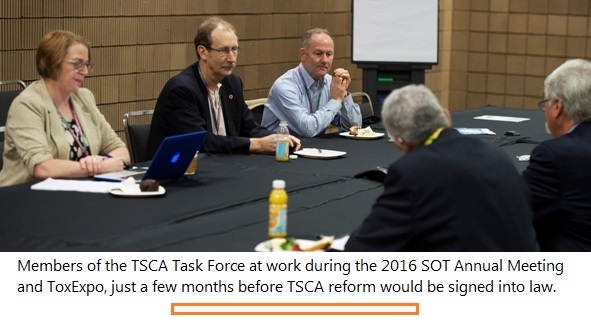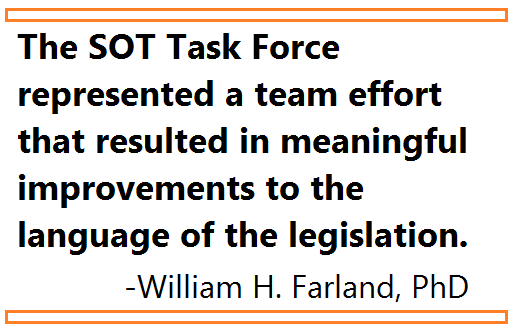
Each year, approximately a quarter of SOT members express a desire for the Society to engage in advocacy activities on behalf of toxicology. Aware of this interest, SOT Council continually monitors regulatory and political policy throughout the world to identify opportunities for engagement by the Society through activities, such as meetings and forums, webinars, and support of partner organizations. In special circumstances, SOT’s efforts extend directly to interactions with government officials.
 “Advocacy takes several forms: lobbying, grassroots engagement, whitepapers or policy documents, education of specialized or technical information, and public relations or communications outreach,” explains Joel D. Kassiday, vice president of HillStaffer LLC. “Unfortunately, many people refer to the entirety of these efforts as ‘lobbying’ rather than the more accurate term, ‘government relations.’ This is an important distinction because professional associations often times focus their efforts on the creation of policy documents and providing technical information, rather than traditional lobbying. Such is the case with SOT.”
“Advocacy takes several forms: lobbying, grassroots engagement, whitepapers or policy documents, education of specialized or technical information, and public relations or communications outreach,” explains Joel D. Kassiday, vice president of HillStaffer LLC. “Unfortunately, many people refer to the entirety of these efforts as ‘lobbying’ rather than the more accurate term, ‘government relations.’ This is an important distinction because professional associations often times focus their efforts on the creation of policy documents and providing technical information, rather than traditional lobbying. Such is the case with SOT.”
The specific case Mr. Kassiday is referencing is the government relations work undertaken by the SOT Toxic Substances Control Act (TSCA) Task Force for the last six years with guidance the past three years provided by HillStaffer.
“We talked frequently with legislative staff members, reviewed many drafts of legislative language, and submitted a variety of written comments over the last six years,” says the TSCA Task Force Chair William H. Farland, PhD, Colorado State University, “but we never showed a preference for one legislator’s bill over another’s. We were focused exclusively on the science, making sure the language was accurate and also flexible enough to allow for continued evolution of the practice of toxicology and its use in risk assessment.”
The TSCA Task Force was formed in 2010 with the goal of making sure that if and when an update to the 40-year-old TSCA was enacted that the legislation met three objectives:
- Affording flexibility in selection of the best available science for generating and evaluating information used in the safety and risk assessment process.
- Protecting the authority of the US Environmental Protection Agency (US EPA), working with the scientific community, to judge when and how to apply new techniques and methods.
- Ensuring the terms and concepts used in the legislative language that apply to the science of toxicology are consistent, accurate, and unambiguous.

These goals and this legislation were of great importance to SOT because while TSCA is a US-based law, its influence and implications have a global impact. Daland R. Juberg, PhD, global leader of human health assessment at Dow AgroSciences and former chair of the Task Force, notes that “the 21st century science and toxicology/risk approaches embedded in the recently enacted TSCA reform law brings an opportunity for the US EPA to work with global authorities to harmonize their evaluation processes and standards for risk assessment and regulatory decision-making for chemicals used globally.”
To aid the Society succeed in its goals to help shape a law with such a large impact, it was important that the Task Force remained committed to its specific objectives: “One of the things the TSCA Task Force did well was stay focused on their primary objectives,” says Mr. Kassiday. “They utilized SOT’s deep knowledge base and its broad membership and remained both extemporaneous, yet patient, as the legislative process unfolded. Then, as legislative action occurred, they responded rapidly by providing Congress with analysis of important legislative drafts, specific requests from Congress for assistance, and participating in informational congressional panel roundtables and meetings with key congressional members and their staffs.”
Their patience and action was rewarded in June when President Barack Obama signed the Frank R. Lautenberg Chemical Safety Act for the 21st Century into law.
 “The SOT Task Force represented a team effort that resulted in meaningful improvements to the language of the legislation,” says Dr. Farland. “Voluntary work like this provided legislators with important perspectives on the science of toxicology as they crafted their bill into law. SOT was proud to be a part of this historic accomplishment.”
“The SOT Task Force represented a team effort that resulted in meaningful improvements to the language of the legislation,” says Dr. Farland. “Voluntary work like this provided legislators with important perspectives on the science of toxicology as they crafted their bill into law. SOT was proud to be a part of this historic accomplishment.”
And while legislation as particularly significant to toxicology as TSCA reform may not come around every year, SOT still has a role to play in government relations activities, such as monitoring the implemention of the Lautenberg Chemical Safety Act by the US EPA.
“Congress has a deep and abiding interest in the public policy issues on which SOT and its members and task forces are actively focused. Each year Congress addresses many of the key policy issues that are important to SOT,” says Mr. Kassiday.
“SOT can and will continue to engage in providing technical advice and objective analysis and research to government officials as the need and opportunity arises as part of our commitment to increasing the impact of toxicology,” says SOT President John B. Morris, PhD, ATS, University of Connecticut.
Thank you to the members of the Task Force for their efforts: Susan J. Borghoff, PhD, DABT, ToxStrategies Inc.; Deborah A. Cory-Slechta, PhD, University of Rochester Medical Center; Dennis J. Devlin, PhD, ExxonMobil Corporation; Ronald S. Filler, PhD, Drug Development Consultants Inc.; Michael A. Gallo, PhD, ATS, DABT, Rutgers University; George M. Gray, PhD, George Washington University; Michael P. Holsapple, PhD, ATS, Michigan State University; Mark Lafranconi, PhD, DABT, Tox Horizons LLC; James C. Lamb IV, PhD, DABT, ATS, Exponent Inc.; Moiz Mumtaz, PhD, US Centers for Disease Control and Prevention; Lisa Tonner Navarro, PhD, DABT, ERT, Givaudan Flavors Corporation; Nancy J. Rachman, PhD, ILSI North America; Ruthann A. Rudel, MS, Silent Spring Institute; Robert S. Skoglund, PhD, DABT, CIH, Covestro; and especially the Task Force chairs, Daland R. Juberg, PhD, ATS, Dow AgroSciences, and William H. Farland, PhD, Colorado State University.